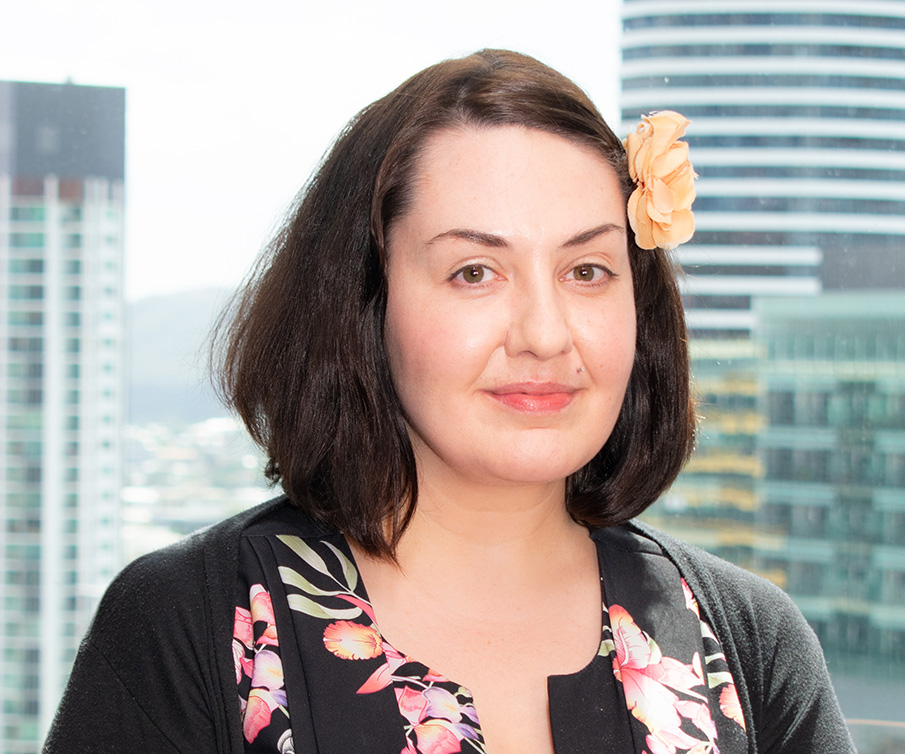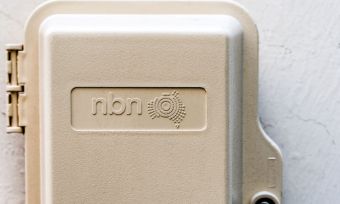Compare Internet Plans & Providers
Canstar Blue compares internet plans from a large range of NBN providers so you can find the data, speed and price combination that suits you. See if you can find a better broadband plan using Canstar Blue’s internet comparison table.

Instantly compare 350+ Canstar Blue expert rated products based on the inputs below
-
BYO Modem, no setup fees
-
BYO Modem, no setup fees
-
Modem Included, no setup fees
-
Get 24 months Fetch TV entertainment.
-
BYO Modem, no setup fees
-
BYO Modem, no setup fees
-
BYO Modem, no setup fees
-
This plan is exclusively for Seniors Card and Senior Savers Card Holders.
-
BYO Modem, no setup fees
-
BYO Modem, no setup fees
-
Modem Included, no setup fees
-
Get 24 months Fetch TV entertainment.
-
BYO Modem, no setup fees
-
Get 24 months Fetch TV entertainment.
-
BYO Modem, no setup fees
-
BYO Modem, no setup fees
-
BYO Modem, no setup fees
-
BYO Modem, no setup fees
Bundle and Save up to $120 off your NBN plan over 12 months with Dodo Energy plans. T&Cs Apply
-
Modem Included, no setup fees
Showing 10 of 259 results
Unsure of a term in the above table? View glossary
The initial results in the table above are sorted by Value Rank (High-Low) , then Cost per month (Low-High) , then Provider Name (Alphabetical) . Additional filters may have been applied, see top of table for details.
SPONSORED
NBN Fixed Line | No lock-in contract
-
Special Offer: Save $10/month for the first 6 months!
-
$0 modem available. Plus, get 50%off SIM Plan fees for the first 6 months.
-
New customers only. T&C apply.
Latest in internet
Why compare internet plans with Canstar Blue?
Easy to compare
Compare internet plans from more than 36 Australian NBN providers to help you find the best deal
100% free to use
Our internet comparison tool is free to use, and we won’t ask you for personal details when you search
Switch with confidence
Alongside showing the best prices, we also rank NBN plans based on our unique ‘value score’
Internet guides and resources
Use Canstar Blue’s internet guides and articles to help you understand your NBN and broadband connection, troubleshoot your speeds and performance, and find a better internet plan and deal for your home and family.

Choosing an internet plan

Internet speeds explained

Internet tips and fixes

Internet savings and costs
National Broadband Network (NBN)
NBN plans are now the most widely-used broadband type in Australia. The best value NBN plan for you depends on factors such as your household size, how you use the internet, and your budget.
Customers can choose between seven NBN speed tiers, including:
- NBN 12 (also known as Home Basic I)
- NBN 25 (Home Basic II)
- NBN 50 (Home Standard)
- NBN 100/20 (Home Fast)
- NBN 100/40 (Fast Pro)
- NBN 250 (Home Superfast)
- NBN 1000 (Home Ultrafast)
The faster the tier, the higher the price, so to find the best plan you’ll need to figure out which NBN speed is right for you.
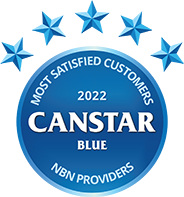 NBN Provider: Most Satisfied Customer Award Winner
NBN Provider: Most Satisfied Customer Award Winner
Each year, Canstar Blue surveys thousands of NBN users to determine which provider offers the best customer satisfaction.
Energy giant-turned-telco Origin is the winner of our 2022 Most Satisfied Customers award for NBN providers, achieving a five-star score for overall customer satisfaction and for bill and cost clarity. Origin also received four stars for speed, customer service, value for money and ease of setup.
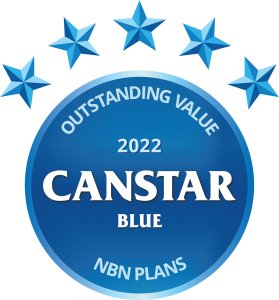 Outstanding Value Award Winner for NBN Plans
Outstanding Value Award Winner for NBN Plans
Canstar Blue’s Outstanding Value Award is based on our unique value rank methodology, and highlights providers offering superior value and features.
Our 2022 award for NBN plans goes to TPG, which also won in 2021. TPG’s competitive prices, fast speeds and flexible plans make it a consistent standout in the NBN space, with options available for all budgets and usage needs.
Outstanding Value: NBN Plans
Mobile Broadband
Mobile broadband uses the same mobile 3G, 4G and 5G networks as home wireless broadband, but is designed to be portable and isn’t a great replacement for your home internet connection. You can connect via a SIM card, USB dongle, or WiFi hotspot, making it a portable internet option that’s good for travel, or as an NBN backup.
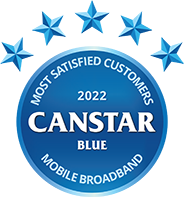 Mobile Broadband Provider: Most Satisfied Customer Award Winner
Mobile Broadband Provider: Most Satisfied Customer Award Winner
Canstar Blue’s annual Most Satisfied Customers award for Mobile Broadband is determined from feedback provided by thousands of Australian mobile broadband customers.
ALDI Mobile is 2022’s best-rated mobile broadband provider, and also won our award in 2021, 2020 and 2019. Customers gave ALDI Mobile five stars for overall satisfaction, speed and coverage, bill and cost clarity, and for ease of setup.
Best-Rated Mobile Broadband
Home Wireless
Home wireless broadband is a popular alternative to NBN, and uses a plug-in modem to connect multiple devices to the internet wirelessly. This type of broadband uses the same 3G, 4G and 5G networks that connect your phone to the internet, and can be a good replacement for NBN or ADSL depending on where you live and the network coverage available.
Learn more about internet in Australia
Unlimited data plans
Compare from Australia’s best unlimited data internet and NBN plans
5G home internet plans
Find out if 5G home internet is right for you in Canstar Blue’s guide to 5G broadband
Wireless routers
Upgrade to a better modem-router combo by comparing Canstar Blue’s best-rated brands
How to choose the best internet plan for you
Find the right speed
The best broadband speed for you will depend on how you use the internet at home, as well as the number of people in your household.
Set a budget
The best plan is the right mix of price and features, but knowing how much you’re willing to spend can help narrow down your options.
Compare plans
Use Canstar Blue’s free NBN comparison tool to compare hundreds of NBN plans and find the right deal.
Choosing an internet provider and plan doesn’t have to be complicated. But with hundreds of plans from close to 200 providers available, it can be hard to narrow down the best choice for your home.
Canstar Blue recommends the following steps when picking the perfect internet provider.
1. Which internet providers are available at my address?
Knowing the type of connection offered at your home can help guide you to the best internet provider. If your address is NBN-ready and connected to fibre technology, you’ll have a huge number of plans to choose from, but if you’re only eligible for fixed wireless or satellite NBN your choices are more limited. Similarly, you may also have access to non-NBN fibre networks such as Opticomm or Gigacomm. And if 4G or 5G coverage is strong in your area, you may prefer a home wireless plan instead.
2. What are my internet needs?
Working out how you use your home internet will help you work out how much data you will need and most importantly, speed. Light users may be better suited to lower download speeds, but if you’re a heavy streamer, downloader or gamer – or have multiple people in your home online at the same time – you’ll probably want something faster, with speeds of 50Mbps or higher. You may also want to consider the upload speed if you’re working from home, video calling or sharing large files.
Most NBN and fibre plans include unlimited data as standard, but very light users may want to look for cheaper plans with capped data to find a better deal. Home wireless plans may also come with a monthly data limit, but 5G internet is generally unlimited.
3. Does my internet provider offer extras?
While no-frills plans are available, some customers prefer an internet provider that offers extras such as a home phone line, and included modem, or bundling options such as mobile plans or electricity and gas.
Several providers also offer entertainment add-ons like Netflix, Fetch TV or Binge, and free trials may also be available. Bigger names like Telstra and Optus also offer gaming optimisation add-ons, with features such as static IP address and lower latency.
4. Which internet provider meets my budget?
Of course, finding the best internet provider will also depend on what you’re willing to spend each month. Going in with a budget will help you narrow down the best providers and plans, but you should also check for extra fees such as start-up or activation costs, and look out for early termination charges if you opt for a plan with a contract.
5. Compare internet providers and plans
Once you know the kind of internet plan you’re looking for, then it’s worth comparing plans from a range of providers to see what’s available. Don’t be afraid to check out smaller or lesser-known brands alongside the big telcos, as these providers often sell competitive speeds for lower prices.
If you’re looking at NBN plans, at Canstar Blue, our free NBN comparison table compares plans from a range of internet providers, from the big ISPs to some of the popular smaller telcos. You might also want to consider the customer satisfaction ratings of providers to get a general idea of what other Aussies think about their internet provider.
List of Internet Providers in Australia
There are over 190 internet providers in Australia offering a range of services, including NBN plans. If you’re looking for internet providers that offer internet services other than NBN, many of the providers listed below offer a range of different products.
At Canstar Blue we compare NBN plans from over 30 providers, including:
FAQs about internet plans & providers
Meet our internet experts
Canstar Blue Editorial Team
Canstar Blue has a skilled team of experienced journalists, content writers and subject matter experts dedicated to producing factual, up-to-date and well-researched information.

Christine Seib
Editor-in-Chief

Tara Donnelly
Telco Editor

Emma Bradstock
Telco Specialist
Canstar Blue Data & Research Team
Canstar Blue’s Research Team provides the expertise that powers our Star Ratings and Awards, designed to help Australian consumers make more informed purchasing decisions.

Mitch Watson
Group Manager, Research & Insights

Joshua Sale
Ratings Manager

Breanna Gream
Data Insights Team Lead

Josh Filosi
Data Insights Analyst

Erin Jackson
Telco Data Analyst

Amy Nghiem
Data Analyst
Important information
For those that love the detail
This advice is general and has not taken into account your objectives, financial situation or needs. Consider whether this advice is right for you.


